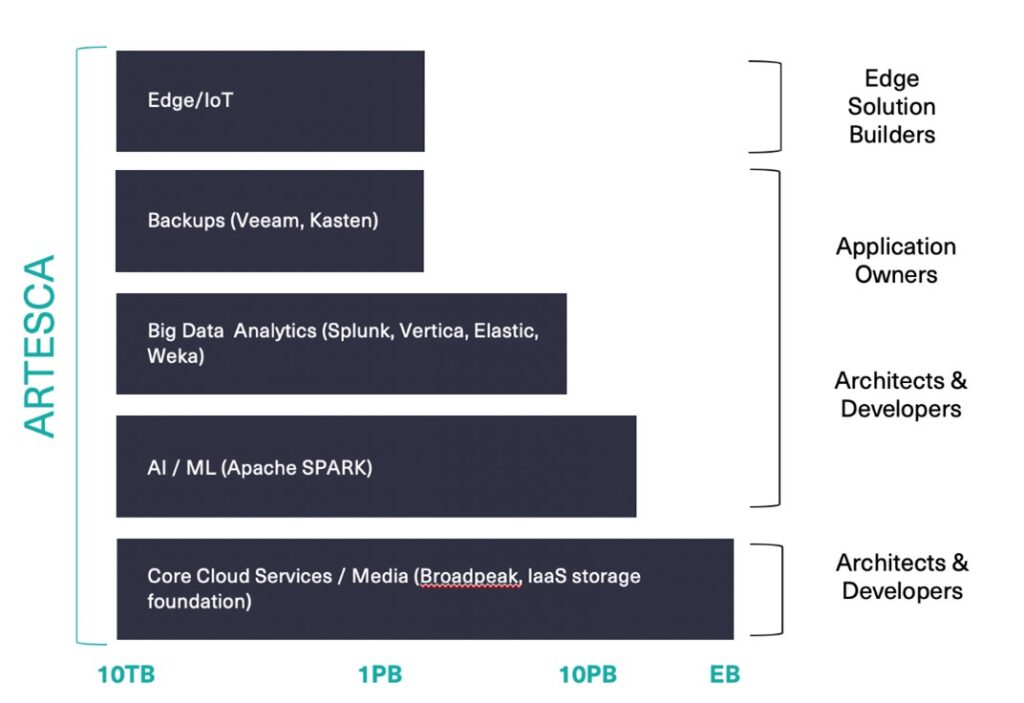On ARTESCA. Q&A with Wally MacDermid
Q1. In today’s app-centric world, what are the main challenges in data management and data governance?
The main challenges in data management and governance boil down to one word: growth. The growth of data is exploding. According to IDC’s Global DataSphere Forecast 2020, 188 zettabytes of data are going to be created, captured, copied and consumed in 2025 alone. (A zettabyte is a comically large amount of data equal to 1,000 exabytes or a billion terabytes.) This data is being created everywhere: by traditional enterprise applications deployed in data centers; by new SaaS applications deployed in the cloud; by new industrial-purposes applications deployed at smaller and smaller edge locations; by the billions of smart phones; and more! Companies struggle to store this data efficiently, to mine this data via analytics to find answers or spot trends, and to control who has access to what data based on local or regional governance regulations.
Q2. Scality® introduced ARTESCA, a cloud-native object storage solution designed for Kubernetes. What is it?
ARTESCA is lightweight, cloud-native object storage software.
ARTESCA is lightweight by:
- Starting as small as a single server — a major differentiator vs. other scale-out systems that require a cluster of three or more servers to start. This single server starting point means it can be deployed in more places, such as in edge computing environments.
- It is super easy to manage and can be grown one server at a time.
- It is object-only, so it doesn’t have the complexity and weight of a POSIX file system.
ARTESCA is cloud-native due to:
- A fully containerized software stack — all services are packaged and executed as containers.
- The entire software stack is deployed and orchestrated on Kubernetes. In the first release, in order to enable deployment on bare-metal servers (from HPE initially), ARTESCA comes pre-packaged with our own MetalK8s Kubernetes distribution, which is a mature and hardened technology that has been shipping for several years. Over time, this will be expanded to support emerging third-party Kubernetes distributions. We are currently considering environments such as HPE Ezmeral Container Platform, VMware Tanzu, and Red Hat OpenShift.
- Support for the popular Amazon S3 API for object storage access, a natural access method for cloud-native apps in Kubernetes.
- Support for comprehensive management and monitoring over RESTful APIs, including Prometheus-compatible APIs.
Q3. Who will benefit most from this new product? Why?
HPE and Scality believe there are three groups who will benefit from ARTESCA and the HPE platforms on which ARTESCA runs. The first group is line-of-business teams within larger enterprises who have started to develop and deploy their own applications without relying on traditional IT. Certainly many of these applications go directly to the public cloud, but more and more LOB teams want the option of an on-premises private or hybrid cloud that provides fast object storage with easy operations and organic growth. The second group is companies (traditional enterprises service providers, etc.) building edge solutions where small capacity storage is required along with the ability to federate that data back to a private core or public cloud. The third group is application architects (and their teams) building applications that need “bundled” object storage (this could include many commercial applications such as backup, video, medical imaging, etc.). Often, these internal teams or commercial vendors want to provide a complete package that includes not only their application, but also the required storage.
Q4. What are the key benefits in offering a container-based design?
According to Gartner (3 Critical Mistakes That I&O Leaders Must Avoid With Containers), “By 2023, more than 70% of global organizations will be running more than two containerized applications in production, up from less than 20% in 2019.” Container-based application development has become so popular because it augments the benefits introduced by hardware virtualization offerings such as VMware. Containerization enables applications that can run anywhere (on-premises, in the cloud) in consistent, predicable environments (easier for developers to code for) with a very high level of isolation between components (fewer conflicts, easier to recover if there are problems, etc.)
Q5. Why is Kubernetes so important?
Kubernetes is an open-source project first developed by Google. It is important simply because it is being adopted so widely and is popular with a rapidly growing number of developers (see Gartner quote above).
Q6. What are the top three use cases that benefit most from the use of ARTESCA?
Primary applications that will leverage ARTESCA are new and emerging applications in AI/ML, big data analytics and edge computing. Many of these applications are Kubernetes-based and will naturally use S3 object storage, so they are a great fit for ARTESCA. Also, S3-enabled backup applications, such as Veeam and Kasten, will be able to use ARTESCA at smaller (sub 100TB) entry points.
The following diagram shows the use cases ARTESCA will likely be deployed for initially.

Q7. Can you briefly explain how the ARTESCA co-design by Scality and HPE worked in practice?
HPE and Scality have had a worldwide, strategic partnership for object storage solutions since 2014. Together, we have 100s of joint customers running Scality products on 1,000s of HPE platforms managing almost an exabyte of data. Our close collaboration – across product management, engineering, sales, marketing, and support – enables us to deliver solutions for many different types of use case and workloads. HPE and Scality partnered on the launch of ARTESCA so that customers could deploy on a single-node (one server) system with 10s of TB up to many servers and 100s of PB or even Exabytes.
We’re also partnering with analytical partners like Vertica to provide analytics on top of ARTESCA. Consider the power of an ACID-compliant database that uses ARTESCA as its main data repository. Vertica offers a separation of compute and storage model that maps very well to the stack. You can quickly scale resources up and down, isolate workloads and optimize infrastructure costs.
Qx. Anything else you wish to add?
Thank you very much for the opportunity to be interviewed!
…………………………………………

Wally MacDermid, Vice President, Strategic Alliances, Scality.
Wally MacDermid is Vice-President of Strategic Alliances and Business Development for Scality, world leader in object and cloud storage. Wally has spent his career in customer and partner-facing roles for companies in the systems management, virtualization, storage, and cloud markets. At Scality, Wally is responsible for the company’s hardware, cloud, and ISV alliances including the HPE global OEM alliance.
Resources